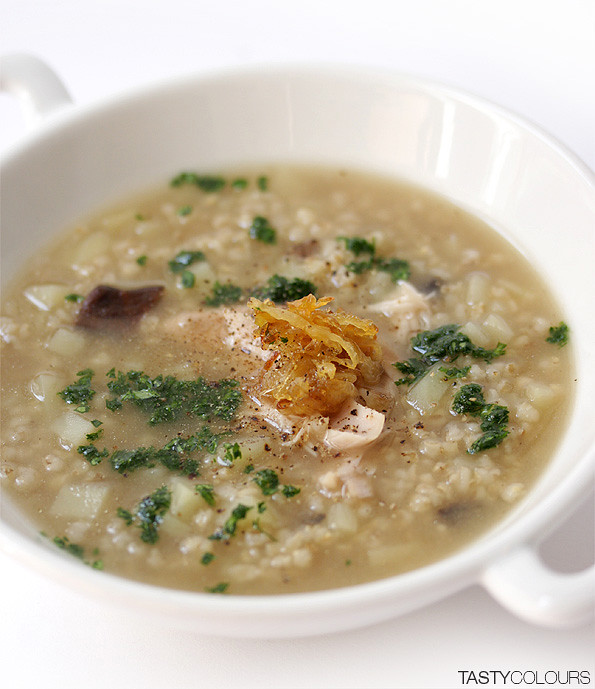When I created my blog, I promised myself that irrespective of how busy I would be, I will always find time to publish at least one post per week. Today we are in the middle of November and several long weeks have passed since my last post. This is how dreams change into reality – one cannot do everything.
I hope that those five difficult weeks of hard work will turn into my favor in January (this is when the Government will publish results of the competition) and that I will be able to share some good news with you.
I had no time to cook regular, warm dishes, except for my daughter, who – on the other hand – has no taste for anything at the moment. Always no, no, no, not good!
On the contrary, I was eating « in between », meaning quickly, not complicated or simply I was forgetting that I was hungry. I could not believe that it was me, a person, who loves to cook and eat so much. After two weeks my stomach shrank to the size of a dried raisin. I was full after one sandwich and too tired or just too lazy to cook a proper dinner.
Do you like soups?
A few days ago I read an article according to which, in Poland, despite the fact that we own cars, mobile phones and shiny kitchens, the revolution did not affect our culinary habits. According to some statistics (I do not know who prepared them) Polish people, today, cook and eat nearly the same way as our parents did. The only radical change shows that they do not make huge supplies, as we did during the communist era.
Allegedly we eat a bit healthier, but still quite greasy. The standard Polish daily menu is: sandwiches for breakfast (didn't I tell you that in my post about sandwiches), a “nutritive” and rich soup or meat, potatoes and.... sometimes …. salads and vegetables for the main meal which is “obiad”. And again sandwiches for dinner. Only 10% to 15% of Polish society, mostly young, better educated people experiment in their kitchens with food from other countries.
According to the article, Polish people still love to eat soups (always made from meat or vegetable broth) and eat the largest quantities of soups per year in the World (around 72 l per capita). Contrary to the south of Europe, where “veloutés” or “moulinés” are more popular, our soups consist of larger pieces of meat and/or vegetables – partially because this comes from our traditions, partially because of the climate.
I agree that the tradition of eating soups was, and still is, strong. For example, in autumn and the winter, thick soups with “kasha” are popular, as Polish people are used to eating quite a lot of “kasha” grains (for example, barley, buckwheat, and others). In Polish, “krupnik” is the name of a soup with barley, and comes from the word “krupy”, meaning “kasza”, porridge. This type of soup is known from at least few hundred years, therefore it really is a traditional and ancient dish.
“krupnik” is often served to children. I will not exaggerate too much if I state that a lighter version of the soup, with no bone stock, is served to really young kids, under one year old. When I was a kid, I hated it.
In Polish language the word “krupnik” has another meaning as well. It is also a type of sweet honey and herb vodka, which you can find in every Polish liquor store, prepared after a traditional formula.
Today's recipe is made with rabbit meat. However, you can replace it with whichever meat you like, beef, chicken, or veal. You can make a vegetarian krupnik as well, without any meat. The soup is usually served with barley, but sometimes I use various grains, for example, bulgur or quinoa. Caramelized onion is my own idea; you will not find it in traditional krupnik recipes.
Barley Soup (Krupnik) with Caramelized Onion
Ingredients
Serves 4 to 6
For the soup
Rabbit – 21 oz (600 g) (preferably a body and two legs)
Pearl barley – 3.5 oz (100 g)
Carrots - 2 medium, peeled and washed
Root parsley or parsnip - 1 medium, peeled and washed
Celery root - 1/3 medium, peeled and washed
Leek - 1 small, washed and cut into halves
Onion - 1 peeled and cut into halves
Garlic clove - 1
Potatoes – 7oz (200 g), peeled, washed and cut into small cubes
Bay leaves - 2
Allspice - 3 grains
Black pepper - 4 grains
Dried ceps – 5 to 6
Sour cream – ½ a cup (120 ml)
Fresh parsley - 2 tablespoons, finely chopped
Salt
Pepper
For the caramelized onion:
Onion - 2 medium, peeled and cut into very thin slices
Olive oil - 3-4 tablespoons
Soak mushrooms in about 300 ml of water (1.25 cup) for at least 2 hours.
Prepare the broth: In a saucepan, bring to a boil about 1,6 l of water (1.7 quarts)
Add the meat, pepper grains, all spice and bay leaves.
Cook for about 30 minutes.
Then add carrots, root parsley, celery root, leek, onion, garlic, mushrooms and their soaking water.
Cook for another 30 minutes, until the vegetables and mushrooms become soft.
In the meantime, prepare caramelized onions:
In a hot frying pan, heat olive oil and put onions. Simmer for between 20 and 30 minutes, over a low flame until soft, golden and caramelized.
Mix often and do not let the onions burn.
Reserve.
Put barley in a thin strainer and wash it under running water, then strain and put aside.
Once the broth is ready, strain it.
Separate meat from the bones and slice it according to your liking.
Cut carrots and root parsley in small cubes; slice the mushrooms and put aside. Throw away all other leftovers.
Bring the broth to a boil again and add pearl barley.
Cook for about 5 minutes, under cover, on a medium flame, then add potatoes and cook under cover until the barley and potatoes are soft.
Finally add sliced meat, mushrooms, carrots and root parsley.
In the meantime, in a cup, mix a bit of broth with cream.
Remove the soup from the heat, add the cream mixture to the soup, mix everything well but do not cook. Season with salt, pepper and some freshly chopped parsley.
Serve immediately, hot, sprinkled with warm caramelized onions.









17 comments:
Ja uwielbiam zupy w okresie jesienno-zimowym. Jeśli chodzi o polskie tradycyjne, to jestem strasznym ortodoksem :). Albo krupnik, albo grzybowa, albo pomidorowa, albo paprykowa (a nie np. pomidorowa z papryką) itd. Chociaż dla odmiany, z czystej ciekawości, takie nietypowe połączenia też chciałabym posmakować.
Pozdrawiam!
Kiedys sie zastanawialam, czy kruknikowi mozna zrobic zachecajace, apetyczne zdjecie... i dzis widze ze mozna, a jakze:) Piekna fotka, ciekawy wpis (zreszta ja zawsze u Ciebie!).
Pozdrawiam serdecznie.
Krupnik to zupa mojej Córki.
Dal mnie brzmi sycąco,domowo,smacznie.
Taką porcję chętnie bym przygarnęła...
Na taki krupnik warto bylo poczekac nawet kilka tygodni, fajnie, ze znowu jestes ;)
Absolutely beautiful soup.
I could easily crawl inside of a bowl of this! :-)
U mnie też dzisiaj krupnik. Tylko bez takiej cudnej cebulki i śmietany. Wersja na nasze chore brzuchy opanowane przez jesiennego rotawirusa. Dobrze, że jesteś z powrotem.
Oh, what a lovely bowl of soup. It looks truly nourishing, warm and comforting. I had no idea Poles ate so many sandwiches! I'd love to hear more about that. :-)
I read this post with great interest; I too am curious to know who conducted this study and how many people were in their sample study!
I love hearty soups like this one and find that the caramelized onions add depth of flavor to the soup.
And you're back on air! Great!
I'm probably gonna repeat myself, but if Polish restaurants served more of our traditional foods like this then we'd have absolutely nothing to be ashamed of. Polish would be the next Thai, or maybe... maybe even... French?
Ech krupnik, jedna z moich ulubionych zup :) Niestety, nie wróżę mu przyszłości. Młodzi nie gotują ani nie jadają krupniku. Prędzej jakąś tajską albo wietnamską zupę. Krupniczek nie jest modny niestety. A jaki dobry z kaszy jaglanej, spróbuj kiedy :) Ze śmietaną nie jadłem jeszcze, u mnie w domu się nie praktykowało.
Zerknij może tutaj:
http://fotoforum.gazeta.pl/72,2,777,90151396,90151396.html
I accidentally tripped onto your blog, it's very well done. I am American, living in Italy, of Polish heritage. I love cooking, and of course being in Italy I have a big advantage. One thing, I tend to make lots of soups, especially in this season. I remember my dad used to do these. I throw any fresh vegetables in the pot that I happen to have, and grains, barley, etc. Now thanks to you I know where this really comes from! My Polish heritage!
Thanks
elena Januszewski
I have never cooked with rabbit, but this soup looks wonderful. So perfect for a cool night. I may have to try to find some rabbit!
Z obietnicami czasem tak bywa, ale gdy potem wracasz z taką zupą i to w dodatku z królikiem to już pełnia szczęścia :)
'Krupnik' to jedno z nielicznych polskich slow, ktore zna moj maz ;) I przy okazji jedna z naszych ulubionych zup, choc u mnie w wersji vege (bo maz vege ;)).
Ten dodatek karamelizowanej cebuli brzmi swietnie!
Pozdrawiam Magdaleno!
I know how you feel. I've been busy and am trying to publish one post per week. It's hard!
Oh your daughter is so cute. I would imagine she would say that haha. I have eaten rabbit but never cooked it! This is very intriguing. However, only the look, it looks like Asian porridge :)
My partner asked me recently if I could cook krupnik and for some reason I though it will not be nice with pearl barley. Now I know I have to try, you recipe sounds good, even if I will not manage to get rabbit I will use something else instead. I love the idea of toppin it with caramelised onions. :)
I hope you are keeping warm, take care!
Uwielbiam krupnik :) a dawno nie robiłam. Dopóki aura na dworze łaskawa, moją kuchnią jest głównie ogród ;) zupy znad ogniska pachną i smakują nieziemsko :) potrzebny jest tylko kociołek http://www.meble-ogrodowe-sklep.pl/kociolek-wegierski-farmcook-inox-trojnogu-p-1071.html
a także sprzyjająca pogoda, dobra atmosfera i podobnie jak w kuchni entuzjazm :)))
Post a Comment